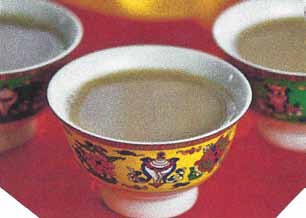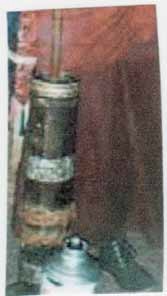
| What is Flavor and Fortune? |
| How do I subscribe? |
| How do I get past issues? |
| How do I advertise? |
| How do I contact the editor? |
Read 12953106 times
Connect me to:
| Home |
| Articles |
| Book reviews |
| Letters to the Editor |
| Newmans News and Notes |
| Recipes |
| Restaurant reviews |
| Article Index (all years, slow) |
| List of Article Years |
| Article Index (2025) |
| Article Index (last 2 years) |
| Things others say |
| Related Links |
| Log In... |
| Authors |
| Categories & Topics |
Tibetan Butter Tea
| by Jacqueline M. Newman |
Beverages
Fall Volume: 2017 Issue: 24(3) pages: 22 to 23
Known as po cha or cha suma, this churned tea is something Tibetans love. To make it they use black tea leaves, yak butter, and salt mixed with water. This tea is unique to Tibetans and others in and near the Himalayan mountains. It is an acquired taste somewhat like a salty soup with no sweetness. Many wonder why it is so loved, but those that do like it, adore it. Always served to guests, they commonly drink several bowls in small sips; and we must advise they never drain their bowl of tea entirely. They do not need to because someone constantly tops it off.

It is common to boil black tea leaves for a long time, add the butter with some using butter made from cows, and adding lots of salt. This they strain with a colander or a horse-hair devise, and allow it to sit on a brazier keeping it warm all day. They use special tall churns, and if you go to a monastery, a monk might pour some for you. Modern folk do use tea bags, but for those that go out for Tibetan tea, these churns are what to expect. As to the butter, it is added at the end, just before drinking.
Tibetans, in their language, also call it ja srub ma which they tell us means churned tea. If one goes to Nepal or Bhutan one gets it there, too. Correctly, it has lots of black tea leaves scraped off a tea brick of pressed leaves often made with pu-er which is a fermented tea. Tibetans we know like to drink theirs with yak butter, an acquired taste. They like to drink it morning, noon, and night, and in their climate, it does a great job of keeping chills away from them.
Most families have a pot of this tea keeping it warm usually in a copper pot on their stove day and night. They drink it often, know it has lots of calories, and always serve some to their guests. Most sip it slowly from wooden or China cups they like filled to the tippy top. They never leave their tea untouched after they pour it, nor do they wait to have it after it cools down. They like it very hot, and start drinking it immediately after theirs is poured. Some they might pour into or on or over their tsampa.
Tsampa is a major food to Tibetans. It is made with ground highland barley, tastes nutty, and they love theirs with yak butter as it takes away all chills they feel in their very cold climate. One chap educating us said that butter tea was brought to their country when Princess Wenchang came from China to marry their King named Songsten Gampo. That was in the seventh century CE.
Then the Tibetan plateau was divided into three regions known as the U-Tsang, Kham, and Amdo regions. The first or U-Tsang is modern-day Tibet. The second or the Kham region is Tibet’s Autonomous Region along with the western part of the Sichuan Province, the southern part of the Qinghai Province, and the northwestern part of the Yunnan Province. The third or Amdo region includes both the northern and eastern parts of the Qinghai Province, the southwestern part of the Gansu Province, and the northern part of the Sichuan Province, each having small differences in culture, culinary, and language.
Amdo people, for example, like to drink salty milk tea but not salty butter tea. The poor folk in this region sell their butter. They milk their yaks every day, spring and summer, heat that milk, and separate the butter from the milk and cream; then they use the milk for their tea and their tsampa. They like both mixed with some curds and with many black tea leaves. They tell us they eat highly caloric tsampa with their hands and use no flatware to do so.
In the Kham region, nomads and others like their tea slightly sweetened and mixed with yak milk. The nomads in the Tibetan Autonomous Region of U-Tsang like theirs made into what they call ‘butter tea.’ Many of them live at seventeen thousand feet above sea level and they really do need many calories to stay warm and healthy. They like good mind-body balance, strong blood and muscles, and they like to eat fat and marrow, and drink many fluids.
These people also like to meditate, trek long distances, go on pilgrimages, and tend to their other daily activities.
One chap told us he uses extra salt to regulate his water balance. It counteracts many of the diuretics he gets in his black tea. He added that folks in his region have been using Tibetan tea since Tang times (618 - 709 CE) when the Chinese Princess came and married their Tibetan King.
He said the barley in their tsampa adds fiber, vitamins and minerals that he needs; and he specifically mentioned the selenium and magnesium in it. He confirmed that tea is always on his stove, he drinks it often, and it helps him when trekking long distances. He also often adds rice, orange rind, and spice(s) to increase its taste and texture.
He said that his king taught him and his people to appreciate five fermented pu-er types of tea. They are bod jha tea made with scraped black brick tea, butter, and salt; jha thang tea made with similar tea and small pieces of butter floating on its top; jha kar tea which is weaker and with less caffeine and more milk than the other teas mentioned; mang jha tea which is a special tea reserved for ceremonies; and njar jha tea, a sweeter tea made with fewer spices and made differently. He said all these teas are loved and often served in special wood or china tea cups with lids. He added that they are decorated with silver or gold on their exteriors, and that this king taught him and others that before they sip any tea to chant a prayer and blow the butter around the top of the tea. He did tell us that this king taught his people to energetically stir some tsampa into their tea, and to sip it slowly while enjoying it.

| Tibetan Butter Tea is Po Cha |
|---|
1 heaping Tablespoon loose black tea from the Pemagul area of Tibet
1. Boil five or six cups of water called chaku, and put
the tea leaves in and boil it for five minutes or so, then
strain the tea leaves out of the water.
|


Copyright © 1994-2025 by ISACC, all rights reserved
Address
3 Jefferson Ferry Drive
S. Setauket NY 11720